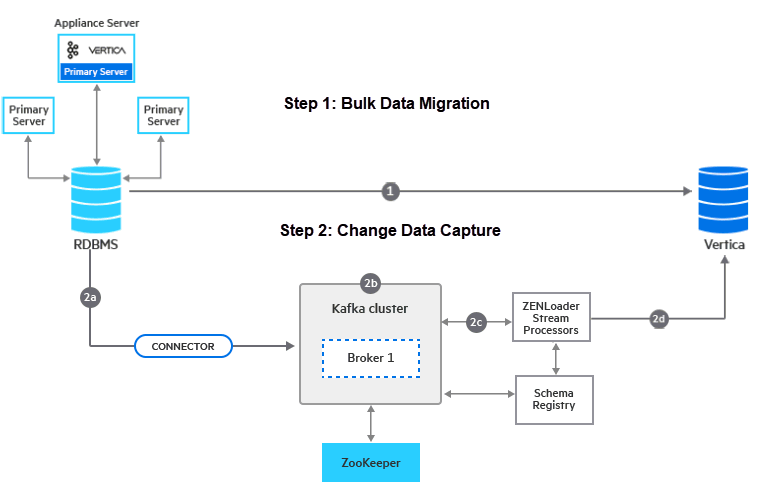4.1 Workflow to configure Vertica in the Zone
The following workflow provides a high-level overview of configuring the Vertica database and its related components on a single server zone.
NOTE:You do not have to enable ZooKeeper in your zone, as it is by default enabled on your first Primary Server as soon as you upgrade or install the ZENworks 2020 release version.
-
Enable Kafka in the zone: Packaged with the ZENworks 2020 virtual appliance build, Apache Kafka will initially be in a disabled state. Use the ZMAN utility to enable Kafka and its related services (Kafka connect and schema registry). For more information, see Procedure to Configure Vertica and Kafkaon a Single Server.
-
Enable Vertica in the zone: Packaged with the ZENworks 2020 virtual appliance build, Vertica will initially be in a disabled state. You need to use the ZMAN utility to enable Vertica in the zone. Ensure that you enable Kafka in the zone, before enabling Vertica. For more information, see Procedure to Configure Vertica and Kafkaon a Single Server.
-
Migrate data: Migration of data from the existing RDBMS to Vertica includes two parts, which is represented in the following illustration:

Step
 - Bulk Data Migration: As soon as Kafka and Vertica are enabled in the zone, you need to perform bulk data migration from the existing RDBMS to Vertica by executing a Configure action. After migrating data in bulk, ZENworks will start processing queries from Vertica for all the dashlets in ZENworks. For more information, see Procedure to Configure Vertica and Kafkaon a Single Server.
- Bulk Data Migration: As soon as Kafka and Vertica are enabled in the zone, you need to perform bulk data migration from the existing RDBMS to Vertica by executing a Configure action. After migrating data in bulk, ZENworks will start processing queries from Vertica for all the dashlets in ZENworks. For more information, see Procedure to Configure Vertica and Kafkaon a Single Server.Step
 - Change Data Capture:After the initial bulk migration process, as and when data is modified in the existing RDBMS, for these changes to reflect in Vertica, the RDBMS syncs with Vertica at an interval of every 15 minutes. Apache Kafka along with ZooKeeper is responsible for performing this sync action. For more information, see Procedure to Configure Vertica and Kafkaon a Single Server.
- Change Data Capture:After the initial bulk migration process, as and when data is modified in the existing RDBMS, for these changes to reflect in Vertica, the RDBMS syncs with Vertica at an interval of every 15 minutes. Apache Kafka along with ZooKeeper is responsible for performing this sync action. For more information, see Procedure to Configure Vertica and Kafkaon a Single Server.